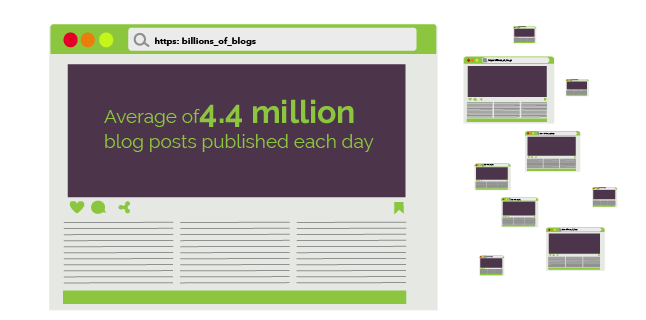Did you know that there’s an average of 4.4 million blog posts published each day?
This means there’s billions of pieces of content that exist on the internet. Many of these have never been removed – with some dating back to the very early days of search engines having been created.

The majority of this content is published once and never reviewed or removed. It’s left to become outdated or become a distant memory in the back end of our website.
It’s exceedingly rare for a piece of content to be so spectacular that it will never become outdated or require improvements over time. Most content you create will need updating at some point, even if it’s just tweaking some broken links or updating your research to be as up to date as possible.
So, it’s important to conduct regular content gap analysis. This way you can review your existing content and find out which pieces require improvements or updates.
If you don’t, you will soon find your content is no longer the most relevant source of information for your audience. Which also means you’ll start to see your rankings drop.
What is an SEO Content Gap Analysis?
Content gap analysis is the process of finding gaps within your existing content. By identifying these gaps, you can improve your content and maintain its relevance for your audience.

Once you have found these content gaps, you can either refresh old content or create new content to focus on that area and try to rank for those keywords.
For instance, you may discover your audience is interested in a niche topic which you don’t have any content on. Therefore, you can adjust your strategy accordingly and create some content on this topic, which is relevant to your audience.
This could lead to greater visibility for your site, as you’ll be ranking for more search terms than before.
You’ll also be creating relevant content that your existing audience is actually interested in.
SEO Content Gap Analysis: Should I Be Doing it?
To be successful in today’s online market, you need to incorporate good SEO practices, whilst focusing on having quality, engaging and relevant content.
Gone are the days when you could simply add a few relevant keywords with on-page SEO to rank well.
Today – in the words of Google – it’s about ‘creating compelling and useful content’ which ‘makes [your] expertise and authoritativeness clear.’
And how are you meant to prove your credibility as an expert if you don’t have up-to-date content? Or the freshest and most recent industry developments on your site?

A few years ago, Google even rolled out a ‘fresher results’ update. It prioritises newer or recently refreshed pages, as these are likely to offer searchers the most accurate and up-to-date information.
So, if you want to want to improve, or maintain your rankings, you need to regularly conduct a content gap analysis to find areas of your website to improve on, and ensure you’re the most relevant brand on the market.
How To Do An SEO Content Gap Analysis
There are two main ways to do an SEO content gap analysis:
- Competitor-based content gap analysis
- Market-based content gap analysis
Each one has a different methodology and will present different opportunities for your brand’s content marketing strategy.
Competitor-Based Content Gap Analysis
With SEO, the easiest way to get some great insights with little to no budget is by conducting a competitor analysis. And when it comes to a content gap analysis, it’s no different. It’s a quick and easy way to find gaps within your old content and make changes that can produce speedy results.
Most companies choose this method, as it’s the one which requires very few tools and time – making it a very cost-effective approach.

Unlike a market-based content gap analysis (more on that later), a competitor-based content gap analysis is quicker to do. And, it gives you some easy ideas on how to improve your content.The process involves:
1. Determining your current rankings
As with anything in SEO, you should start your competitor analysis by grasping where you as a brand currently stand.
You can review your current rankings for a single page of content, or for your entire website. The latter is great if you’re looking for a more in-depth website review.
This can be done easily by using Google Webmaster tools, or through other third party specialist tools. We use SEMrush, for example.
I’d recommend keeping these rankings stored somewhere handy, like a spreadsheet. This will allow you to keep track of them over time and monitor any changes with ease.
2. Finding out what keywords your competitors’ page(s) rank for
Once you have a grasp on where you currently rank, you want to find out how you stand against your competition.
You can do this by directly searching the same keywords you’re aiming for into your web browser and taking note of their rankings. Or, similarly for your own site, by using third-party tools that will do the hard work for you.
Again, I would try to monitor these rankings, either on a spreadsheet or with a third-party tool. That way you can keep a close look on how your content improvements affect their rankings.
3. Compare your rankings
After you have identified your competitor’s rankings, it’s time to compare them against your own.
Compare the keywords you rank for against your competitors. Then create a list out of the ones you are not ranking for. This will help you know what you need to target when refreshing your content.
4. Theorising
Once you’ve understood where your weaker content stands against your competitors, you need to determine why your page isn’t ranking for particular keywords and search terms.

Is it because you haven’t been using the right keywords? Is your content lacking detail? Does your competitor have a great backlink profile?
This stage may take a bit of lateral thinking. But, if you take a look at your closest competitors’ content and see what they’re doing differently, you’ll soon realise what makes their content stand out.
It will also give you a greater idea of how much work you’re going to have to put in to make a significant impact.
If your content doesn’t offer as much detail or information, you may need to do lots of research to make it full and content-rich.
Alternatively, your pages may take a longer time to load or your images may be blurry. You can fix this by resizing your image files to make improvements.
However, these are suggestions only. You should analyse all aspects of your competitors on and off-page SEO before deciding what changes you need to make.
5. Putting your plan into action
Once you’ve identified the factors that affect your rankings, it’s time to put your theory into action.
Whatever it is your content needs, make sure it’s the best quality and most relevant piece of content to address your searcher’s query. It’s your best chance of ranking highly.
This 5-step process is fairly straightforward and easy to implement. And, with the right tools, the first few steps can be completed within a few easy clicks.
Market-Based Content Gap Analysis
A market-based content gap analysis involves more work than a competitor gap analysis but can open up more opportunity for your content strategy.
Although it takes more research, time and effort, it will offer greater insights into how to adapt your strategy to better suit your audiences’ needs and find new content creation opportunities.
Where a competitor analysis shows you where the gaps in your content are, a market-based analysis will show you where the loopholes in your competitors content plan are.

You’ll need to think more creatively and out of the box, but this type of audit can help you reap more rewards.
The process involves:
1. Researching and refining your target audience
In order to look at the successful content in your market, you first need to have a clear idea of who your target market is.
You may think you already have a clear idea of who your audience is. Especially if you did extensive market research during the initial development stages of your content marketing strategy.
However, just as the marketplace changes, so does your audience.
Your audience are living, breathing humans. Their search demands and needs will constantly evolve.
So, you need to keep up with their demands and adapt your content strategy to suit their needs. If not, you’ll waste time creating content which your audience is not interested in consuming.
To find out more about them, don’t be afraid to strike up a conversation. If you have a significant following on your social media, use it as a platform to speak to them. Or if you have a comments section in your blog, use call-to-actions at the bottom of your post to encourage discussion.

You’ll be able to engage in genuine, meaningful conversations, and gain some valuable insights into who your audience is, and what excites them.
As you refine your audience, you’ll probably discover you have more than one type of customer.
For example, you might be an established computer brand with a loyal following. So you may have customers who know more about you and your brand who are looking for more technical pieces of content, such as how to replace a laptop screen.
But you may also have lots of new customers visiting your site who simply want to know about the best laptops to buy for a student.
So, you may need to tweak your content strategy to suit all variations of your ‘target market.’
2. Keyword Research
Once you’ve established your target market, it’s time to carry out some keyword research. This will help you to find out what topics and questions you’ve not covered in your content plan.
Keyword research is very easy to do, and is vital to any SEO strategy.
It’s how you discover what content your audience is looking for and the way they’re searching for it. It presents an opportunity to create new content that fulfils their search intent.
Like your audience research, you will have likely performed extensive keyword research at the start of your SEO journey. Taking the time to regularly review these search terms will ensure your content remains consistently high in audience search results.
3. Determining your rankings
If you haven’t been keeping track of your rankings throughout your SEO strategy, it’s a good idea to start now.
Again, this will help you see where you currently stand in the market. And, size up how much of a ‘jump’ your rankings need to take in order to reach your goals.
You can do this simply by searching the term on a search engine and counting down the places to your page’s ranking. Alternatively, you can use Google’s webmaster tools.
4. Theorising
Before making any changes to your content plan, work out why you rank in the position you do for that particular keyword.
Is your content old or missing valuable information and research? Is it slow to load due to large image files? Does the layout overwhelm your users and lead them to bounce off because it’s too text heavy?
Or is it because it’s a new long-tail keyword which you haven’t come across before? This indicates you need to create new content which targets the new search term.
Whatever the reason, only you will be able to work out what it is. It will take a bit of trial and error to see what works.
5. Actioning your plan
Once you’ve worked out what improvements you need to make to your content plan, it’s time to implement them!

If this means tweaking your old content, make the necessary edits as soon as possible. This will be a quick and easy way to improve your SEO.
However, you need to create new content, make sure you’re creating something unique. Ensure it’s different from the rest of the pages that are currently ranking.
You could take a new angle or focus on a particular niche. Alternatively, you could create something visually different to what already exists on the market.
As I mentioned above, a market content gap analysis does require a bit more creative thinking. However, it’s only when you come to action your plan that you have the opportunity to really do so.
Unfortunately, you won’t see any instant results. So be prepared to step out of your comfort zone and wait to see what impact your content has.
And, it’s also important to remember that you should never assume that producing content will have you ranking highly. Search engines are complex machines, and there’s no ‘one size fits all’ strategy that will mean producing one piece of content can make you rank highly.
If you don’t see the results you first hoped for, examine your content. Compare it against all the possible on-page ranking factors and the more technical aspects of SEO.
Content marketing is a constant improvement process. You will always be checking, improving and changing your content to try and improve your results.
Summary
A content gap analysis is another vital part of your overall SEO strategy. It’s the next logical step in the process once you’ve produced a solid foundation of content.
It’s all about finding the gaps in your existing content. The gaps which stop you from ranking above your competitors, or for a particular search term or phrase.
The process is very easy to do, and we’ve looked at the two main ways to do an analysis in this article. That is, market-based content gap analysis and competitor-based gap analysis.
If you choose to do a market-based content gap analysis, this will take more time and effort. You’ll need to research and refine your target audience, carry out keyword research and produce new content that’s unique from what’s already out there.
In contrast, doing a competitor-based content gap analysis won’t be as in depth. You’ll only be tweaking your content based on what your competitors have done. However, there are plenty of free tools which help to make it a speedy process. And, you won’t be creating new content, so you can make some quick improvements to your SEO.
Whichever route you choose, once you’ve made the necessary changes, you’ll need to be patient. This is because you need to wait for the search engine to crawl and index your content again to find out if your rankings have improved.
Outsourcing Your SEO to a Marketing Consultant
Although relatively easy to carry out, a content gap analysis is only part of your overall SEO strategy. And, if you want to make sure yours is as effective as it can be, you’ll need to take the time to understand your market. Only then, will you be able to see the opportunities presented to improve your content.
If you’re a relatively small or new start-up business, it’s unlikely you will have the time or resources readily available to make your content marketing strategy the best it can be.
You may want to consider outsourcing your SEO to a marketing consultant such as myself.
Whether you’re at the very early stages of developing your SEO strategy, or have an established website, my team and I can help you. We’ll create an actionable plan that will have you hitting your goals in no time.
To find out more information about how we could help your business to increase rankings and drive more traffic to your site, why not get in contact today. I’d be happy to have an obligation-free chat about your goals and talk you through some of our previous work.







